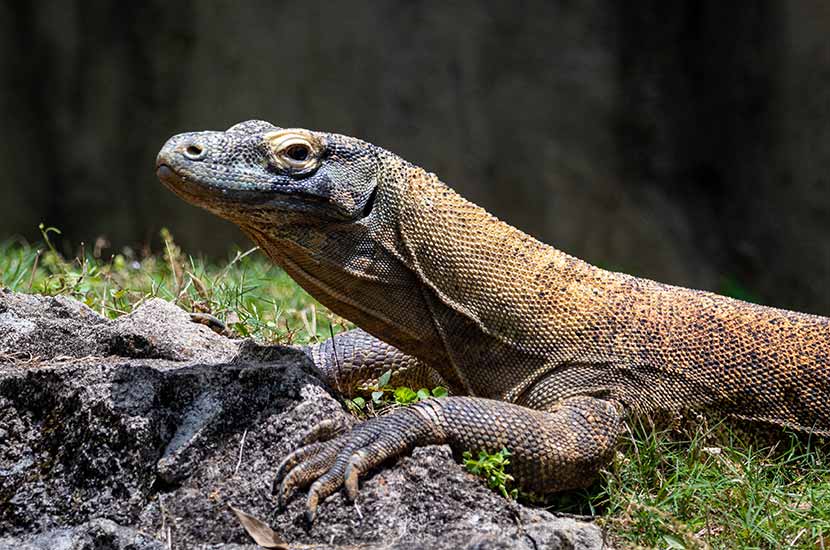Crocodile monitors, also called Croc monitors, Salvadori’s monitors, and Papua monitors are large carnivorous lizards native to the island of New Guinea. Their preferred habitats are the mangrove swamps and coastal rainforests. These monitors can be difficult to tame down due to most individuals in the pet trade having been wild caught, however, they will begin to recognize daily rituals such as feeding, cleaning, etc. This top predator of the rainforest is diurnal and arboreal despite its large size of 6-10 feet. Monitors are incapable of autotomy (“tail drop”). In the wild, this species is listed as CITES Appendix 2. Croc monitors typically live 10-15 years in captivity with excellent care.
An interesting note to remember about this species is that the gums are subject to bleeding. There is still great debate whether this is a fear response, from teeth erupting, or from the aggressive manner in which they attack and devour prey. Croc monitors enjoy swimming and lounging in water. In New Guinea they were thought to be evil spirits that climbed trees, walked upright (typically when checking their surroundings), breathed fire, and devoured men. However, they were also believed to give warning if crocodiles were near which is why they earned the name Crocodile monitor. These monitors relish swimming and have been known to sleep underwater much to the dismay of many first time keepers.
Feeding and Diet
In the wild, Crocodile monitors are carnivores, consuming small mammals, eggs, insects, carrion, birds, reptiles, and fish. These aggressive eaters will consume nearly anything placed in front of them. However, variety and balance are key to a healthy monitor. In captivity, most monitors are fed birds (such as quail and chicken), rodents (rats and mice), occasional fish, rabbits, shelled hard boiled eggs, and Mazuri Carnivore diet. Young monitors can be offered crickets, dubia roaches, giant mealworms, and earthworms.
Hatchlings should be fed every day to every other day. Crocodile monitors under 2 years old should still be fed 3-4 times a week until they reach sexual maturity and roughly adult size. Adults should be fed 1-2 times a week depending on their body condition (obese monitors should eat less often than under weight monitors). Pieces of cooked chicken can be offered as a treat for enrichment as well as training in some individuals. Obesity is a common problem in Croc monitors and food should be fed as meals when adulthood is reached rather than constant supply.
There are various methods and recipes for feeding monitors and commercial diets are an easy option for most keepers. A primary diet of Mazuri Carnivore for adults is recommended with the addition of Mazuri Insectivore diet when feeding young monitors. Lean ground turkey is a welcome addition to any monitor diet as long as it is not the bulk of the diet. All Croc monitors should have their meals dusted with a calcium supplement and a multivitamin supplement should be used once to twice a week.
Enclosure
These lizards are arboreal although they relish swimming and tend to sleep on the ground or underwater. Hatchlings can be easily housed in a 40 gallon aquarium or enclosure of a similar size although they will quickly require larger accommodations. As monitors grow they will need a larger (keeping in mind floor space is important) or a custom enclosure. Once your Croc monitor hits 1-2 years old it is recommended to create a custom enclosure that is at the very least, a 75 gallon aquarium. It is highly recommended to offer an enclosure that is roughly 4-6 feet long, 4-6 feet wide, and 6 feet tall. Adults will require much larger living spaces with particular care given to vertical special requirements. A section or full room is recommended for particularly large individuals. Crocodile monitors require space to roam, climb, and sprawl out. Make sure that all enclosures are sturdy and escape proof. A locking door is recommended especially for wild caught or aggressive adults.
Substrate
There are numerous substrates to offer monitors in their enclosure ranging from complicated naturalistic set-ups to simplistic newspaper. Newspaper, although unattractive to look at, is easily cleaned out and monitors genuinely seem to appreciate hiding under the layers of paper. Butcher paper can be used as a uniform color alternative. Entire enclosures can be covered in top soil but it is hard to clean out effectively and tends to accumulate missed feces as well as offer feeder insects escapes from hungry monitors. If top soil is desired for housing, it is recommended in a section of the enclosure or in a dig box. Dig boxes are particularly helpful for gravid females and also to maintain humidity.
If particulate substrate is desired, aspen and orchid bark are safe alternatives with some owners finding a happy medium with a mixture of orchid bark and topsoil. In this author’s humble opinion, the most enrichment can be achieved by covering the bottom of an enclosure with indoor/outdoor carpet and offering a top soil covered section of the cage (preferably with a lip to keep the soil from covering the rest of the cage). This not only offers multiple substrates to walk on but also offers the keeper ease of cleaning especially if a cement mixing tub or similar is used for the dig spot. All substrates should be changed at least every 2 weeks completely and spot cleaned daily. Croc monitors housed on particulate bedding or soil should be fed in a dish or a separate bin especially if live feeder insects are used.
Lighting
UVB lighting is typically not required for the care of monitors especially those fed whole prey diets. However, improper diet can lead to calcium deficiencies and the addition of an ultraviolet B radiation bulb such as a ReptiSun 5.0 is recommended. Although not necessary, it is recommended to offer exposure to ReptiSun 2.0 or 5.0 during daylight hours.
Heating
Crocodile monitors can happily be housed in ambient temperatures ranging from 80°F on the cooler end of the enclosure and 90°F on the warmer end of the enclosure. These sun loving lizards enjoy basking and large spotlights help create and ideal basking spot of 95°F and 100°F. Ambient temperatures can easily be maintained utilizing under tank heaters, heat cable (only on the outside of the enclosure), heat tape, heat bulbs, ceramic heat emitters, and heat emitting panels. At night, the enclosure should never fall below 75°F.
All heat sources should ideally be kept on a thermostat that allows for proper gradients while offering piece of mind to owners as well. A thermometer should be placed ideally one inch above the substrate on the cooler end of the enclosure. Another thermometer should be placed once inch above the substrate on the warmer end of the enclosure and the one last thermometer at the basking site.
Humidity
Coming from the rainforests of New Guinea, these lizards should be maintained at 70-90% relative humidity. This can easily be monitored using a hygrometer. Humidity can be maintained with large water bowls, pools or bins, misting systems, foggers, humidifiers in large enclosures, and spraying the enclosure 2-3 times a day. Moist topsoil, if offered, will also help preserve the humidity. These monitors require a large amount of water that they can both swim and submerge themselves fully. Pools and ponds are required for larger adults and provide enrichment as well as humidity.
Enrichment
Finding ways to keep monitors entertained and active is as simple as wrapping earthworms or a piece of fish in a lettuce leaf or as complicated as modifying waffle balls (large ones that can’t be swallowed) to hold roaches or meat chunks to move around. Creativity is essential for excellent monitor keeping. Tree trunks, tree branches, and rootstocks make excellent obstacles, hides, and climbing surfaces. These lizards require large amount of climbing surfaces with the addition of shelves and some keepers even modify craft store latticework for climbing. Make sure that all climbing surfaces are more horizontally angled. Dig boxes are essential for working out extra energy and allowing for natural behaviors. Large soaking basins, kid pool or large rubber maid offers enrichment and another way to exercise Crocodile monitors. Hide boxes are also a requirement, especially those that do not have anything to burrow into or hide under. Although a hide box is offering a place to retreat, this is a form of enrichment as well. The addition of straw and hay in the enclosure allows the Crocodile monitor to experience new smells and sensations as they walk and dig through it.
Sources and Recommended Readings
Lizards Volume 2, Manfred Rogner
General Care and Maintenance of Popular Monitors, Michael Balsai
Reptile Medicine and Surgery 2nd Edition, Doug Mader
Monitors, Tegus, and Related Lizards, Patricia Bartlett

